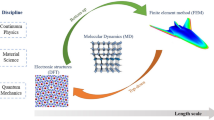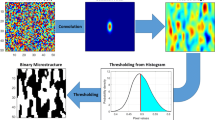Abstract
Standard simulation in classical mechanics is based on the use of two very different types of equations. The first one, of axiomatic character, is related to balance laws (momentum, mass, energy,...), whereas the second one consists of models that scientists have extracted from collected, natural or synthetic data. Even if one can be confident on the first type of equations, the second one contains modeling errors. Moreover, this second type of equations remains too particular and often fails in describing new experimental results. The vast majority of existing models lack of generality, and therefore must be constantly adapted or enriched to describe new experimental findings. In this work we propose a new method, able to directly link data to computers in order to perform numerical simulations. These simulations will employ axiomatic, universal laws while minimizing the need of explicit, often phenomenological, models. This technique is based on the use of manifold learning methodologies, that allow to extract the relevant information from large experimental datasets.











Similar content being viewed by others
References
Amsallem D, Farhat C (2008) An interpolation method for adapting reduced-order models and application to aeroelasticity. AIAA J 46:1803–1813
Brunton SL, Proctor JL, Kutz JN (2016) Discovering governing equations from data by sparse identification of nonlinear dynamical systems. Proc Natl Acad Sci 113(15):3932–3937
Darema F (2005) Grid computing and beyond: the context of dynamic data driven applications systems. Proc IEEE 93(3):692–697
González D, Aguado JV, Cueto E, Abisset-Chavanne E, Chinesta F (2016) kpca-based parametric solutions within the PGD framework. Arch Comput Methods Eng. doi:10.1007/s11831-016-9173-4
González D, Cueto E, Chinesta F (2015) Computational patient avatars for surgery planning. Ann Biomed Eng 44(1):35–45
Kirchdoerfer T, Ortiz M (2016) Data-driven computational mechanics. Comput Methods Appl Mech Eng 304:81–101
Ladeveze P (1989) The large time increment method for the analyze of structures with nonlinear constitutive relation described by internal variables. Comptes Rendus Académie des Sci Paris 309:1095–1099
Lee JA, Verleysen M (2007) Nonlinear dimensionality reduction. Springer, Berlin
Liu Z, Bessa MA, Liu WK (2016) Self-consistent clustering analysis: an efficient multi-scale scheme for inelastic heterogeneous materials. Comput Methods Appl Mech Eng 306:319–341
Lopez E, Gonzalez D, Aguado JV, Abisset-Chavanne E, Cueto E, Binetruy C, Chinesta F (2016) A manifold learning approach for integrated computational materials engineering. Arch Comput Methods Eng. doi:10.1007/s11831-016-9172-5
Michopoulos J, Farhat C, Houstis E (2004) Dynamic-data-driven real-time computational mechanics environment. In: Bubak M, van Albada GD, Sloot PMA, Dongarra J (eds) Computational science—ICCS 2004: 4th international conference, Kraków, Poland, June 6–9, 2004, proceedings, Part III, pp 693–700, Springer, Berlin
Olson GB (2000) Designing a new material world. Science 288(5468):993–998
Peherstorfer B, Willcox K (2015) Dynamic data-driven reduced-order models. Comput Methods Appl Mech Eng 291:21–41
Peherstorfer B, Willcox K (2016) Data-driven operator inference for nonintrusive projection-based model reduction. Comput Methods Appl Mech Eng 306:196–215
Polito M, Perona P (2001) Grouping and dimensionality reduction by locally linear embedding. In: Advances in neural information processing systems 14, pp 1255–1262. MIT Press
Raghupathi W, Raghupathi V (2014) Big data analytics in healthcare: promise and potential. Health Inf Sci Syst 2(1):1–10
Roweis ST, Saul LK (2000) Nonlinear dimensionality reduction by locally linear embedding. Science 290(5500):2323–2326
Tenenbaum JB, de Silva V, Langford JC (2000) A global framework for nonlinear dimensionality reduction. Science 290:2319–2323
Wang Q (2012) Kernel principal component analysis and its applications in face recognition and active shape models. CoRR, abs/1207.3538
Acknowledgments
This work has been supported by ESI GROUP through the ECN-ESI Chair on advanced modeling and simulation of materials, structures and processes as well as by the Spanish Ministry of Economy and Competitiveness through Grants Number CICYT DPI2014-51844-C2-1-R and DPI2015-72365-EXP and by the Regional Government of Aragon and the European Social Fund, Research Group T88.
Author information
Authors and Affiliations
Corresponding author
Ethics declarations
Conflict of interest
The authors declare that they have no conflict of interest
Human Participants Nor Animals
The research does not involve neither human participants nor animals
Informed Consent
All the authors are informed and provided their consent.
Rights and permissions
About this article
Cite this article
Ibañez, R., Abisset-Chavanne, E., Aguado, J.V. et al. A Manifold Learning Approach to Data-Driven Computational Elasticity and Inelasticity. Arch Computat Methods Eng 25, 47–57 (2018). https://doi.org/10.1007/s11831-016-9197-9
Received:
Accepted:
Published:
Issue Date:
DOI: https://doi.org/10.1007/s11831-016-9197-9




